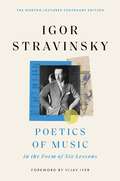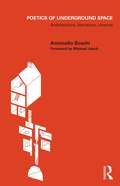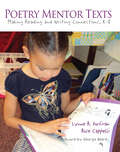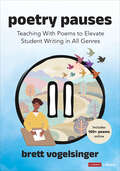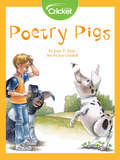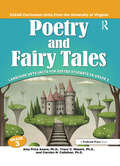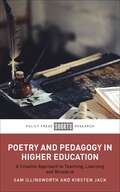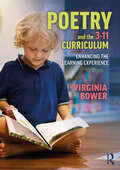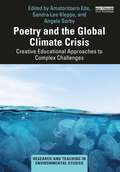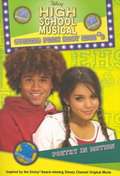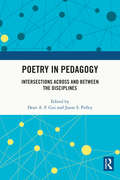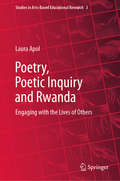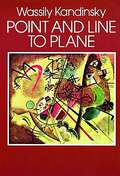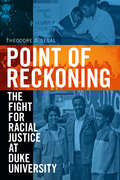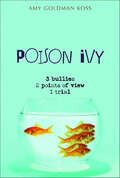- Table View
- List View
Poetics of Music in the Form of Six Lessons (The Charles Eliot Norton lectures ; #1939-1940)
by Igor StravinskyTimeless lessons on the pleasures of listening, the dilemmas of composition, and the meaning of artistic freedom from a founder of musical modernism.In October 1939, Igor Stravinsky took the stage at Harvard not as a conductor but as a speaker. Invited to deliver the prestigious Norton Lectures, he had departed Europe just days after the outbreak of war, leaving behind not only a growing political maelstrom but also his life in France, where his wife, eldest daughter, and mother all had died in the previous year.Poetics of Music offers a snapshot of this pivotal moment in the composer’s biography and career. Delivered at the height of his neoclassical period, which blended the sculptural precision of classicism with distinctively twentieth-century cadences, Stravinsky’s lectures explore both the creative potential and the constraints of tradition. Though he achieved artistic immortality as a genre-defying experimentalist who scandalized audiences in Belle Époque Paris, the Stravinsky we find here is more circumspect, defending the dignity of formal conventions against the more anarchic currents of modernist experimentation. Tradition, he argues, is not a relic of a bygone past but a living force that animates the present. And true artistic freedom emerges not only in moments of revolutionary inspiration but also through strict deference to the formal requirements of the work.Like his compositions, Stravinsky’s lectures are ambitious and at times bombastic, punctuated by wit and polemic. Ranging widely from the phenomenology of rhythm to the fate of high culture in the Soviet Union, he invites us to reflect on what it is in music that compels us, whether we are hearing one of his polytonal works or a simple birdsong.
Poetics of Underground Space: Architecture, Literature, Cinema
by Antonello BoschiThis book investigates the relationship architecture has with the underground. It provides a broad ranging historical and theoretical survey of, and critical reflection on, ideas pertaining to the creation and occupation of underground space. It overturns the classic dictates of construction on the surface and through numerous examples explores recoveries of existing voids, excavations, caves, quarries, grottos and burrows. The exploitation of land, especially in areas of particular value, has given rise to the need to reformulate the usual approach to building. If the development of urban sprawl, its infrastructure and its networks, generates increasingly compromised landscapes, what are the possible strategies to transform, expand and change the usual relationship between abuse of soil and unused subsoil? Psychological, philosophical, literary and cinematographic legacies of underground architecture are mixed with the compositional, typological and constructive expedients, to produce a rich, diverse and compelling argument for these spaces. As such, the book will appeal to architecture students, scholars and academics as well as those with an interest in literary theory, cinema and cultural studies.
Poetry - From Reading to Writing: A Classroom Guide for Ages 7-11
by Robert HullPoetry – From Reading to Writing covers the process of writing poetry, from reading poems through to writing them. It is intended particularly for teachers at key stage 2 level, but other teachers will also find it valuable. It is clearly and accessibly written and jargon-free. In providing a wealth of practical ideas and activities preparing for the writing of poems, the book also stresses the use of talk, improvised drama and the reading and performance of poems. The author, who has published four collections of poetry, uses his own work and the work of others to explore how creative readings of poems can spark a child’s imagination and lead to original writing. Pupils are encouraged throughout the book to explore different forms of poetry, including: Rhyming and non-rhyming poems Riddles Short poems Haiku, tanka, renga Poems from stories Free verse Narrative poems Poems drawing on current affairs and history This book can be used by both pupils and teachers, and contains motivating tasks and tips to build pupils’ confidence in poetry writing. Explicit links are made throughout to the latest primary framework for literacy, making this an invaluable resource for all practising and trainee teachers who wish to teach poetry in the classroom in a creative and enjoyable way.
Poetry For Dummies (For Dummies Ser.)
by The Poetry Center John TimpaneSometimes it seems like there are as many definitions of poetry as there are poems. Coleridge defined poetry as “the best words in the best order.” St. Augustine called it “the Devil’s wine.” For Shelley, poetry was “the record of the best and happiest moments of the happiest and best minds.” But no matter how you define it, poetry has exercised a hold upon the hearts and minds of people for more than five millennia. That’s because for the attentive reader, poetry has the power to send chills shooting down the spine and lightning bolts flashing in the brain — to throw open the doors of perception and hone our sensibilities to a scalpel’s edge. Poetry For Dummies is a great guide to reading and writing poems, not only for beginners, but for anyone interested in verse. From Homer to Basho, Chaucer to Rumi, Shelley to Ginsberg, it introduces you to poetry’s greatest practitioners. It arms you with the tools you need to understand and appreciate poetry in all its forms, and to explore your own talent as a poet. Discover how to: Understand poetic language and forms Interpret poems Get a handle on poetry through the ages Find poetry readings near you Write your own poems Shop your work around to publishers Don’t know the difference between an iamb and a trochee? Worry not, this friendly guide demystifies the jargon, and it covers a lot more ground besides, including: Understanding subject, tone, narrative; and poetic language Mastering the three steps to interpretation Facing the challenges of older poetry Exploring 5,000 years of verse, from Mesopotamia to the global village Writing open-form poetry Working with traditional forms of verse Writing exercises for aspiring poets Getting published From Sappho to Clark Coolidge, and just about everyone in between, Poetry For Dummies puts you in touch with the greats of modern and ancient poetry. Need guidance on composing a ghazal, a tanka, a sestina, or a psalm? This is the book for you.
Poetry Mentor Texts: Making Reading and Writing Connections, K-8
by Lynne Dorfman Rose CappelliBuilding on the success of Mentor Texts and Nonfiction Mentor Texts, authors Lynne R. Dorfman and Rose Cappelli now turn their attention to poetry. In Poetry Mentor Texts , Lynne and Rose show teachers how to use poems in both reading and writing workshops and across content areas. Written in a friendly, conversational tone, this practical book explores a variety of poetic forms, including poems that inspire response, list poems, acrostic poems, persona poems, and poems for two voices-;versatile forms of poetry that can be used in every grade. Each of these poetic forms has its own chapter featuring five poems with applications for both reading and writing classrooms. Reading connections present skills and strategies to move students forward as readers, helping them to build fluency, vocabulary, comprehension, phonemic awareness, and phonics. Writing connections help students and teachers discover their own voices and grow as poets and wordsmiths as they try out many poetic forms. Poems help students at all grade levels learn to better address complex reading texts, offering them a chance to dig deeper and use higher-order thinking skills. Additionally, Your Turn writing lessons provide a scaffold for seamlessly moving from modeling to the shared or guided experience and the transfer to independent work. The Treasure Chest offers a brief annotation of the poems discussed in each chapter as well as companion pieces that extend and enhance the work of the reading and writing classroom. Poetry Mentor Texts helps teachers across the curriculum guide their students to become not only skilled readers and writers but also more empathetic human beings.
Poetry Pauses: Teaching With Poems to Elevate Student Writing in All Genres (Corwin Literacy)
by Brett VogelsingerUnleash the power of poetry to boost all academic writing Student writing outcomes will transform if we invest more time in the genre we too often ignore: poetry! With Poetry Pauses, Brett Vogelsinger asserts that all good writing takes us to deeper places, whether it’s narrative, argument, informational, or verse. So why not use the palm-size examples of poems to develop students’ skills? This book helps you to Teach techniques such as using sound, pattern, imagery, grammatical structures, and dialogue Select poems from the online companion website for read alouds and writing warm-ups Reshape students’ attitudes about verse with contemporary spoken word and poems by today’s favorite poets Know how to tuck specific poems into any part of the writing process to build your students’ understanding of brainstorming, elaboration, paragraphing, argumentation, and more No matter what students go on to do in life, being able to reach a broad audience with language that engages the whole mind is a gift. The resources here and online will stoke students’ logic and creativity immeasurably.
Poetry Pauses: Teaching With Poems to Elevate Student Writing in All Genres (Corwin Literacy)
by Brett VogelsingerUnleash the power of poetry to boost all academic writing Student writing outcomes will transform if we invest more time in the genre we too often ignore: poetry! With Poetry Pauses, Brett Vogelsinger asserts that all good writing takes us to deeper places, whether it’s narrative, argument, informational, or verse. So why not use the palm-size examples of poems to develop students’ skills? This book helps you to Teach techniques such as using sound, pattern, imagery, grammatical structures, and dialogue Select poems from the online companion website for read alouds and writing warm-ups Reshape students’ attitudes about verse with contemporary spoken word and poems by today’s favorite poets Know how to tuck specific poems into any part of the writing process to build your students’ understanding of brainstorming, elaboration, paragraphing, argumentation, and more No matter what students go on to do in life, being able to reach a broad audience with language that engages the whole mind is a gift. The resources here and online will stoke students’ logic and creativity immeasurably.
Poetry Pigs
by Joan T. ZeierHow could George write a poem? He wasn't a poet. But then George touches down in the Land of Hogs: Poetry Pig Farm! Pigs William Shakespeare and Emily Dickinson help George learn to become a poet.
Poetry and Fairy Tales: Language Arts Units for Gifted Students in Grade 3
by Carolyn M. Callahan Amy Price Azano Tracy C. MissettThe CLEAR curriculum, developed by University of Virginia's National Research Center on the Gifted and Talented, is an evidence-based teaching model that emphasizes Challenge Leading to Engagement, Achievement, and Results. In Poetry and Fairy Tales: Language Arts Units for Gifted Students in Grade 3 students will read and analyze various forms of poetry and write their own poetry anthology. They will learn how to identify and use figurative language to create concrete images from abstract ideas. In the fairy tales unit, students will study fairy tales and folklore to understand how and why societal norms and mores are culturally transmitted. These units focus on critical literacy that includes reading diverse sources, understanding bias and cultural contexts, and creating informed consumers of information.Grade 3
Poetry and Pedagogy in Higher Education: A Creative Approach to Teaching, Learning and Research
by Sam Illingworth Kirsten JackThis book invites us to consider the profound impact that poetry can have in shaping personal and professional development in a higher education setting. Suitable for educators, learners, and practitioners, it offers a transformative learning approach in using poetry for teaching, assessment, research, and reflection. The book includes diverse examples, case studies, and practical exercises, demonstrating poetry's application in personal and professional development in a higher education setting. Each chapter guides readers through these processes, empowering them to integrate poetry into their own teaching and learning practices in a way that is creative, inclusive, and impactful.
Poetry and Sustainability in Education (Palgrave Studies in Education and the Environment)
by Angela Sorby Sandra Lee KleppeThis edited collection offers educators at all levels a range of practical and theoretical approaches to teaching poetry in the context of environmental sustainability. The contributors are keenly aware of the urgency facing the planet’s ecosystems—ecosystems which include all of us—and this volume makes the case that teaching poetry is not a luxury. Each of the book’s three sections works from a specific angle and register. Part I focuses on pragmatic approaches to classroom activities and curricular choices; Part II considers policies and politics, including the role of the UN’s Education for Sustainable Development (ESD) program; and Part III takes a widescreen view, exploring the philosophical issues that arise when poems are integrated into sustainability curricula. This book exemplifies how poetry empowers readers to think imaginatively about how to sustain—and why to sustain—our world, its resources, and its beauty.
Poetry and the 3-11 Curriculum: Enhancing the Learning Experience
by Virginia BowerPoetry can enable learners to engage, learn and have fun, whatever their cognitive, linguistic or social levels and this book provides a great many examples of how this might be achieved. This exciting and innovative text provides a wide range of ideas for using poetry to enhance the early years and primary curricula, and therefore the learning experience of all children. Each chapter contains ideas for pedagogy and practice, underpinned by research and classroom experience ensuring that practitioners will come away feeling much more confident to teach this genre and better enjoy poetry themselves. Throughout, there are discussions around specific pedagogies and practices relating to the use of poetry across the curriculum, as well as resources – including a wide range of poems from diverse countries and cultures and poems in different languages – and activities which can immediately be used in the classroom. Ideas are provided in terms of how poems can be employed in different subject areas, to introduce or reinforce concepts, engage children in more challenging concepts, ensure that lessons are fun and engaging and develop children’s awareness of other people and places beyond their immediate experience. This book is an extremely powerful combination of informed discussion – drawing on ideas from different theoretical perspectives including recent findings from neuroscience – and practical suggestions for every classroom. Armed with this text, practitioners will not only have a very strong idea of how to use poetry to enhance their curriculum but also why this is such a compelling genre.
Poetry and the Global Climate Crisis: Creative Educational Approaches to Complex Challenges (Research and Teaching in Environmental Studies)
by Angela Sorby Amatoritsero Ede Sandra Lee KleppeThis book demonstrates how humans can become sensitized to, and intervene in, environmental degradation by writing, reading, analyzing, and teaching poetry. It offers both theoretical and practice-based essays, providing a diversity of approaches and voices that will be useful in the classroom and beyond. The chapters in this edited collection explore how poetry can make readers climate-ready and climate-responsive through creativity, empathy, and empowerment. The book encompasses work from or about Oceania, Africa, Europe, North America, Asia, and Antarctica, integrating poetry into discussions of specific local and global issues, including the value of Indigenous responses to climate change; the dynamics of climate migration; the shifting boundaries between the human and more-than-human world; the ecopoetics of the prison-industrial complex; and the ongoing environmental effects of colonialism, racism, and sexism. With numerous examples of how poetry reading, teaching, and learning can enhance or modify mindsets, the book focuses on offering creative, practical approaches and tools that educators can implement into their teaching and equipping them with the theoretical knowledge to support these. This volume will appeal to educational professionals engaged in teaching environmental, sustainability, and development topics, particularly from a humanities-led perspective.
Poetry in Motion (High School Musical: Stories from East High #3)
by Alice AlfonsiEveryone at East High is freaking out. In one week, the students in Ms. Barrington's English class will have to recite an original poem in front of the whole school! Chad is usually happy to ham it up no matter who is watching, but the embarrassing memory of a past poetry performance is seared onto his brain--and he's not sure he'll be able to pull off this assignment. Troy enlists Gabriella to teach Chad and the other basketball players that there's more than one way to bust a rhyme. But will she be able to save them from schoolwide humiliation?
Poetry in Pedagogy: Intersections Across and Between the Disciplines
by Jason S. Polley Dean A. F. GuiThe essays compiled in Poetry in Pedagogy: Intersections Across and Between the Disciplines offer praxes of poetry that cultivate a community around students, language, and writing, while presenting opportunities to engage with new texts, new textual forms, and new forms of text-mediated learning. The volume considers, combines, and complements multiform poetry within and beyond existing Teaching & Learning paradigms as it traverses Asia, The Atlantic, and Virtual Space. By virtue of its mélange of intersecting trajectories, across and between oceans, genres, disciplines, and sympathies, Poetry in Pedagogy informs interdisciplinary educators and practitioners of creative writing & poetry involved in examining the multiform through international, cross-disciplinary contexts.
Poetry in the Clinic: Towards a Lyrical Medicine (Routledge Advances in the Medical Humanities)
by Shane Neilson Alan BleakleyThis book explores previously unexamined overlaps between the poetic imagination and the medical mind. It shows how appreciation of poetry can help us to engage with medicine in more intense ways based on ‘de-familiarising’ old habits and bringing poetic forms of ‘close reading’ to the clinic. Bleakley and Neilson carry out an extensive critical examination of the well-established practices of narrative medicine to show that non-narrative, lyrical poetry does different kind of work, previously unexamined, such as place eclipsing time. They articulate a groundbreaking ‘lyrical medicine’ that promotes aesthetic, ethical and political practices as well as noting the often-concealed metaphor cache of biomedicine. Demonstrating that ambiguity is a key resource in both poetry and medicine, the authors anatomise poetic and medical practices as forms of extended and situated cognition, grounded in close readings of singular contexts. They illustrate structural correspondences between poetic diction and clinical thinking, such as use of sound and metaphor. This provocative examination of the meaningful overlap between poetic and clinical work is an essential read for researchers and practitioners interested in extending the reach of medical and health humanities, narrative medicine, medical education and English literature.
Poetry, Method and Education Research: Doing Critical, Decolonising and Political Inquiry
by Esther Fitzpatrick Katie FitzpatrickPoetry can be both political and pedagogical. It is utilised in a variety of ways in research to enhance, critique, analyse, and express different voices. Poetry, Method and Education Research brings together international scholars to explore issues as diverse as neoliberalism, culture, decolonising education, health, and teacher identities. A key strength of the book is its attention to poetry as a research method, including discussions of "how to" engage with poetry in research, as well as including a range of research poems. Poetry is thus framed as both a method and performance. Authors in this book address a wide variety of questions from different perspectives including how to use poetry to think about complex issues in education, where poetry belongs in a research project, how to write poetry to generate and analyse "data", and how poetry can represent these findings. This book is an essential resource for students and researchers in education programmes, and those who teach in graduate research methods courses.
Poetry, Poetic Inquiry and Rwanda: Engaging with the Lives of Others (Studies in Arts-Based Educational Research #3)
by Laura ApolThis book describes the practice of poetic inquiry and takes the reader through the process of translating lived experience into poetry that attends to the lives of others. Using her own writing—from early drafts to published poems—Apol demonstrates elements of poetic inquiry that both give it strength and make it complicated: the importance of craft (the aesthetic); the imperative of accuracy and reliability (the investigative); the significance of ethical responsibility that leads to action (witness); and the centrality of relational connectedness and accountability (withness). Apol raises questions about what it means for poems to function as both research and art, and illustrates what happens when there are irresolvable conflicts between the demands of the poem and a commitment to relationship. Throughout, Apol addresses her white privilege, as well as the dominant white/colonial narrative that often seeps into arts-based work unless it is overtly and critically addressed. The book goes beyond arts-based research, speaking as well to other forms of cross-national, cross-cultural research. It is a call for relational scholarship that moves toward action, a heart-rending teaching, a post-traumatic aesthetic map laid down with clear and poignant theory and praxis to extend, serve and guide.
Poets of the Bible: From Solomon's Song of Songs to John's Revelation
by Willis Barnstone“The vividness and beauty of the language emerge in a fresh way . . . with evocative simplicity.” —Robert Alter, professor emeritus of Hebrew and comparative literature, University of California, Berkeley The world’s greatest poetry resides in the Bible, yet these major poets are traditionally rendered into prose. In this pioneering volume of biblical poets translated in English, Willis Barnstone restores the lyricism and power of the poets’ voices in both the New and Old Testaments. In the Hebrew Bible we hear Solomon rhapsodize in Song of Songs, David chant in Psalms, God and Job debate in grand rhetoric, and prophet poet Isaiah plead for peace. Jesus speaks in wisdom verse in the Gospel, Paul is a philosopher of love, and John of Patmos roars majestically in Revelation, the Bible’s epic poem. This groundbreaking volume includes every major biblical poem from Genesis and Adam and Eve in the Garden to the last pages of Alpha and Omega in Paradise.
Point and Line to Plane
by Wassily Kandinsky"I had the impression that here painting itself comes to the foreground; I wondered if it would not be possible to go further in this direction."Thus did the young Russian painter Wassily Kandinsky (1866–1944) react to his first viewing of Monet's Haystack, included in an 1895 Moscow exhibit of French Impressionists. It was his first perception of the dematerialization of an object and presaged the later development of his influential theories of non-objective art.During study and travel in Europe, the young artist breathed the heady atmosphere of artistic experimentation. Fauvism, Cubism, Symbolism, and other movements played an important role in the development of his own revolutionary approach to painting. Decrying literal representation, Kandinsky emphasized instead the importance of form, color, rhythm, and the artist's inner need in expressing reality.In Point and Line to Plane, one of the most influential books in 20th-century art, Kandinsky presents a detailed exposition of the inner dynamics of non-objective painting. Relying on his own unique terminology, he develops the idea of point as the "proto-element" of painting, the role of point in nature, music, and other art, and the combination of point and line that results in a unique visual language. He then turns to an absorbing discussion of line — the influence of force on line, lyric and dramatic qualities, and the translation of various phenomena into forms of linear expression. With profound artistic insight, Kandinsky points out the organic relationship of the elements of painting, touching on the role of texture, the element of time, and the relationship of all these elements to the basic material plane called upon to receive the content of a work of art.Originally published in 1926, this essay represents the mature flowering of ideas first expressed in Kandinsky's earlier seminal book, Concerning the Spiritual in Art. As an influential member of the Bauhaus school and a leading theoretician of abstract expressionism, Kandinsky helped formulate the modern artistic temperament. This book amply demonstrates the importance of his contribution and its profound effect on 20th-century art.
Point of Reckoning: The Fight for Racial Justice at Duke University
by Theodore D. SegalOn the morning of February 13, 1969, members of Duke University's Afro-American Society barricaded themselves inside the Allen administration building. That evening, police were summoned to clear the building, firing tear gas at students in the melee that followed. When it was over, nearly twenty people were taken to the hospital, and many more injured. In Point of Reckoning, Theodore D. Segal narrates the contested fight for racial justice at Duke from the enrollment of the first Black undergraduates in 1963 to the events that led to the Allen Building takeover and beyond. Segal shows that Duke's first Black students quickly recognized that the university was unwilling to acknowledge their presence or fully address its segregationist past. By exposing the tortuous dynamics that played out as racial progress stalled at Duke, Segal tells both a local and national story about the challenges that historically white colleges and universities throughout the country have faced and continue to face.
Point, Click, Quilt!: Turn Your Photos into Fabulous Fabric Art
by Susan Brubaker Knapp“[A] gem . . . [Susan] provides a wealth of tips and examples for composing great photographs that have potential to make for lovely quilts.” —Piece, Love & Happiness!Fiber artist and designer Susan Brubaker Knapp teaches quilters how to compose and shoot dynamic digital photos from a quilter’s perspective. With fun, creative workshop-like exercises in art quilting, you’ll learn how to turn those photos into small art quilts, both realistic and abstract, combining traditional fabrics with innovative materials. Every quilter can succeed with Susan’s achievable designs and accessible techniques.16 artful appliqué projects inspired by digital photographsLearn how to shoot better photos and turn them into art quilt designsBoost your creativity with new tools and techniquesUse unique materials to achieve your vision, including Tyvek, foils, paints, and more“Shows how a photo can be a starting point for something truly artful . . . The focus is on creating good design, not on simply recreating a scene . . . anyone who ever made a piece inspired by a favorite photo can learn something from this beautiful book.” —And Sew It Goes . . .“I sat down and went through each page and gobbled it right up . . . Susan shares how to take great photos for translation into an art quilt.” —IHAN (I Have a Notion)
Points of Disruption in the Music Education Curriculum, Volume 1: Systemic Changes (CMS Pedagogies and Innovations)
by Marshall Haning Jocelyn A. Stevens Brian N. WeidnerFor decades, scholars in the field of music education have recognized the need for growth and change in our approach to teaching music, yet despite these calls for change, the music education curriculum today remains remarkably similar to that of a century ago. Points of Disruption in the Music Education Curriculum, Volume 1: Systemic Changes is one of two volumes that bring together applied suggestions, analyses, and best practices for disrupting cycles of replication in the curriculum of K-12 and collegiate music education programs in the United States and beyond, considering disruption as a force for positive change. Identifying specific strategies for interrupting or reimagining traditional practices, the contributors provide music teachers and music educators with a variety of potential practical approaches to creating changes that foster a better musical education at all levels of the curriculum.This first volume focuses on systemic changes, including topics like professional development, hiring practices, ableism and universal design, rhizomatic learning, and how to implement disruption across the music education profession. Each chapter contains specific action steps and suggestions for implementation. Bringing together five thought-provoking chapters, this concise volume offers a diverse set of concrete strategies that will be useful to a wide range of music education stakeholders, including teachers, administrators, and curriculum designers.
Points of Viewing Children's Thinking: A Digital Ethnographer's Journey
by Ricki Goldman Ricki Goldman-SegallThis book is about learning and ethnography in the context of technologies. Simultaneously, it portrays young people's "thinking attitudes" in computer-based learning environments, and it describes how the practice of ethnography is changing in a digital world. The author likens this form of interaction to "the double helix," where learning and ethnography are intertwined to tell an emergent story about partnerships with technology. Two school computer cultures were videotaped for this study. Separated not only by geography -- one school is on the east coast of New England and the other on the west coast of British Columbia on Vancouver Island -- they are also separated in other ways: ethnic make-up and inner-city vs. rural settings to name only two. Yet these two schools are joined by a strong thread: a change in their respective cultures with the advent of intensive computer-use on the part of the students. Both school communities have watched their young people gain literacy and competence, and their tools have changed from pen to computer, video camera, multimedia and the Internet. Perhaps most striking is that the way they think of themselves as learners has also changed: they see themselves as an active participant, in the pilot's seat or director's chair, as they chart new connections between diverse and often unpredictable worlds of knowledge.
Poison Ivy
by Amy Goldman Koss"IwithVY: I told Ms. Gold about how The Evil Three have been after me, feeding off me since fourth grade.MARCO: It isn't a very pretty story, so if you're looking for 'nice,' you better ask someone else.ANN: We just have to come up wiht some witnesses for our side. Think! Does anyone owe you any favors?BRYCE: I figure, Dude, why not make a little spare change on the side? A buck a bet. All's I has to do was explain that liable was civil for guilty, and they swarmed like flies."Eight first-person narrators give different versions of the same event. Lessons about the inner workings of the judicial system pale beside the insights into human nature. With pathos and a great deal of humor, Amy Goldman Koss keeps you turning pages.
